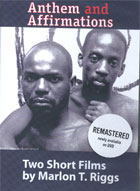
Anthem; Affirmations 1991 (Anthem); 1990 (Affirmations)
Distributed by Frameline, 145 Ninth St., Suite 300, San Francisco, CA 94103; 415-703-8650
Produced by Marlon T. Riggs
Directed by Marlon T. Riggs
DVD, color and b&w, 19 min. total (Anthem – 9 min.; Affirmations – 10 min.)
Sr. High – Adult
African American Studies, Drama, Film Studies, Gay and Lesbian Studies, Gender Studies, Media Studies, Music, Poetry
Date Entered: 01/07/2011
Reviewed by Kathleen Spring, Nicholson Library, Linfield College, McMinnville, ORMarlon T. Riggs’s two short films Anthem and Affirmations exemplify how many African-American gay men attempted to recast their voices and politicize their actions at the end of the 20th century. In the experimental long-form music video Anthem, Riggs uses repetitive images, cascading voiceovers, and multiple music tracks to “pervert the language” and remake his history as a gay African-American man. The film is clearly emblematic of the early 1990s—the costumes, music, imagery, and backdrops (some of which are reminiscent of music videos from DJ Jazzy Jeff and the Fresh Prince and the sketch comedy series In Living Color) all transport the viewer back to 1991. Riggs juxtaposes fast cuts of a series of images (a cock ring, two men kissing, a pink triangle, a man voguing, a golden cross, native Africans dancing, and a United States flag, among others) and exhorts the viewer to “parade it proudly, flaunt it like a man.” Anthem celebrates the revolution of African-American gay men who recognize the power they have in asserting their rights to life and liberty, particularly in a culture that does not always grant them those rights.
As a companion piece to Anthem, Affirmations also poses questions about cultural and political norms for gay African-Americans. Affirmations begins with a story told by a young African-American gay man about a sexually liberating experience. Direct quotations from his story (shown as titles on a black screen) precede each segment of the tale and serve as a hook to advance the story. The film continues with a glimpse at African-American Freedom Day in Harlem, where gay men marching come face to face with not-so-latent homophobia from some of the spectators. Like Anthem, Affirmations uses montages of images in tandem with voiceovers and music to build layers of meaning for the viewer. Affirmations attempts to make viewers consider the relationship between freedom and sexual desires. Although the film’s footage places it squarely at the start of the 1990s (primarily because of dress), the film’s message continues to be relevant. Recommended.